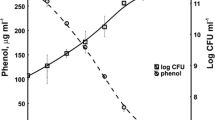Abstract
Expression of antioxidant enzymes [superoxide dismutase (SOD) and catalase] and generation of reactive oxygen species (ROS) in the presence of various hydrocarbons were investigated in two strains of hydrocarbon-degrading microorganism Acinetobacter calcoaceticus isolated from water (VKPM B-10353) and bottom sediment (EMBM-06). Upon biotransformation of hydrocarbons by the studied strains, superoxide generation strengthening by bacterial cells and accumulation of peroxides in the cultivation medium were observed. The strongest superoxide anion radical generation occurred during the incubation of microorganisms with diesel fuel (increasing 12 times and 2 times), cyclohexane (1.8 times and 1.75 times), a mix of benzene and anthracene (4.4 times and 3.7 times), naphthalene (8 times and 1.9 times) and benz(a)pyrene (2 times and 2.3 times) in strains VKPM B-10353 and EMBM-06 respectively, and anthracene (2.8 times) in strain VKPM B-10353. The accumulation of peroxides in the medium took place upon biotransformation of diesel fuel by both strains. Activity of SOD increased considerably and activity of catalase decreased in cells in the medium with hydrocarbons. Decane and crude oil had the maximum impact on SOD expression. Decane increased SOD expression in strains VKPM B-10353 and EMBM-06 24.4 times and 28.5 times, respectively. Crude oil increased SOD expression in strain VKPM B-10353 19 times, and in strain EMBM-06 16 times. The authors assumed that increased ROS generation and oxidizing stress development in bacteria during the biotransformation of various hydrocarbons can have an adaptive character.



Similar content being viewed by others
References
Bell SG, Wong LL (2007) P450 enzymes from the bacterium Novosphingobium aromaticivorans. Biochem Biophys Res Commun 360:666–672
Bell SG, Hoskins N, Xu F, Caprotti D, Rao Z, Wong LL (2006) Cytochrome P450 enzymes from the metabolically diverse bacterium Rhodopseudomonas palustris. Biochem Biophys Res Commun 342:191–196
Gogoleva OA, Nemtseva NV, Bukharin OV (2012) Catalase activity of hydrocarbon-oxidizing bacteria. Appl Biochem Microbiol 48:552–556
Goth L (1991) A simple method for determination of serum catalase activity and revision of reference range. Clin Chim Acta 196:143–151
Kang Y-S, Lee Y, Jung H, Jeon CO, Madsen EL, Park W (2007) Overexpressing antioxidant enzymes enhances naphthalene biodegradation in Pseudomonas sp. strain As1. Microbiology 153:3246–3254
Kato T, Miyanaga A, Kanaya S, Morikawa M (2009) Alkane inducible proteins in Geobacillus thermoleovorans B23. BMC Microbiol 9:60. doi:10.1186/1471-2180-9-60
Lee K (1999) Benzene-induced uncoupling of naphthalene dioxygenase activity and enzyme inactivation by production of hydrogen peroxide. J Bacteriol 181:2719–2725
Lowry OH, Rosenbrough NJ, Farr AL, Randall RJ (1951) Protein measurement with the Folin phenol reagent. J Biol Chem 193:265–275
Metelitsa DN (1983) Aktivatsiya kisloroda fermentnymi sistemami. Nauka, Moskva
Pérez-Pantoja D, Nikel PI, Chavarría M, de Lorenzo V (2013) Endogenous stress caused by faulty oxidation reactions fosters evolution of 2,4-dinitrotoluene-degrading bacteria. PLoS Genet 9(8):e1003764. doi:10.1371/journal.pgen.1003764
Ponce BL, Latorre VK, González M, Seeger M (2011) Antioxidant compounds improved PCB-degradation by Burkholderia xenovorans strain LB400. Enzym Microb Technol 49:509–516
Sazykin IS, Sazykina MA (2013) Vliyaniye antioksidantov na mikrobiologicheskuyu transformatsiyu nefti. Voda Khim Ekologiya 3:75–80
Sazykin IS, Prokofiev VN, Chistyakov VA, Sazykina MA, Vnukov VV (2011) Chemiluminescence analysis of oil oxidizing bacteria Acinetobacter calcoaceticus extracts: effects of the extracts on pSoxS-lux biosensor. Appl Biochem Microbiol 47:400–404
Sun Y, Oberley LW, Li Y (1988) A simple method for clinical assay of superoxide dismutase. Clin Chem 34:497–500
Tamburro A, Robuffo I, Heipieper HJ, Allocati N, Rotilio D, Di Ilio C, Favaloro B (2004) Expression of glutathione S-transferase and peptide methionine sulphoxide reductase in Ochrobactrum anthropi is correlated to the production of reactive oxygen species caused by aromatic substrates. FEMS Microbiol Lett 241:151–156
Wang XB, Chi CQ, Nie Y, Tang YQ, Tan Y, Wu G, Wu XL (2011) Degradation of petroleum hydrocarbons (C6–C40) and crude oil by a novel Dietzia strain. Bioresour Technol 102:7755–7761
Wu RR, Dang Z, Yi XY, Yang C, Lu GN, Guo CL, Liu CQ (2011) The effects of nutrient amendment on biodegradation and cytochrome P450 activity of an n-alkane degrading strain of Burkholderia sp. GS3C. J Hazard Mater 186:978–983
Zenkov NK, Men’shchikova YB (1993) Aktivirovannye kislorodnye metabolity v biologicheskikh sistemakh. Usp Sovrem Biol 113:286–296
Acknowledgments
The study was funded by the Southern Federal University (grant no. 213.01-07-2014/12 PChVG).
Author information
Authors and Affiliations
Corresponding author
Ethics declarations
Ethical standards
The manuscript does not contain clinical studies or patient data.
Conflict of interest
The authors declare that they have no conflicts of interest.
Rights and permissions
About this article
Cite this article
Sazykin, I., Sazykina, M., Khmelevtsova, L. et al. Expression of SOD and production of reactive oxygen species in Acinetobacter calcoaceticus caused by hydrocarbon oxidation. Ann Microbiol 66, 1039–1045 (2016). https://doi.org/10.1007/s13213-015-1188-9
Received:
Accepted:
Published:
Issue Date:
DOI: https://doi.org/10.1007/s13213-015-1188-9




